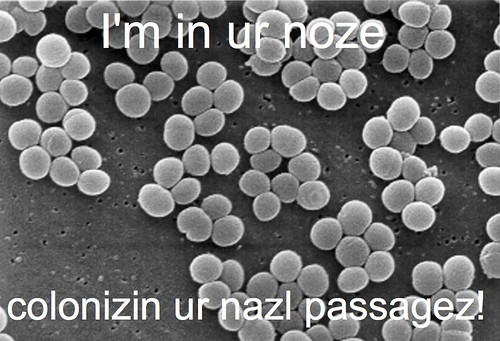
No, MR-CoNS isn't some kind of crazy new conservative, it stands for methicillin resistant coagulase-negative staphylococci. CoNS are relatives of the bacterium Staphylococcus aureus (the 'SA' in MRSA), and are common human commensals--they typically live on us and in us without causing disease.
One of the important things, from a health perspective, about CoNS is that many are resistant to methicillin (methicillin resistance is the "MR" in MRSA). In fact, the resistance mechanism, known as the SCCmec gene cassette, is similar to those found in MRSA (SCCmec is a class of similar, yet genetically distinct genetic elements).
A recent paper looked for CoNS in patients admitted to a French hospital. The findings are disturbing:
The carriage rate of MR-CoNS was 19.2% (25.9% and 16.5% in patients with and patients without previous exposure to the health care system, respectively; P = .09). MR-CoNS strains (n = 83, including 58 MRSE strains with highly heterogeneous MLVA patterns) carried SCCmec type IVa (n = 9, all MRSE), other SCCmec IV subtypes (n = 9, including 7 MRSE), other SCCmec types (n = 15), and nontypeable SCCmec (n = 50). Long range PCR indicated structural homology between SCCmec IV in MRSE and that in MRSA. Complete sequences of SCCmec IVa from 3 MRSE strains were highly homologous to those available for CA-MRSA, including major clones USA300 and USA400.
To translate, 25.9% of patients who had previous exposures to the healthcare system and 16.5% of those who had not were carrying methicillin resistant CoNS (most were S. epidermidis, "MRSE"). To put that in perspective, about 1.5% of healthy people in the U.S. carry MRSA.
The other disturbing finding is that about thirty five percent of the resistant isolates had gene cassettes similar to healthcare associated MRSA, and twenty percent had gene cassettes found in common strains of MRSA.
Not only could these MR-CoNS strains serve as a genetic 'reservoir' of methicillin resistance, but they are becoming an increasing problem themselves. Among immunocompromised patients, MR-CoNS, especially MRSE, are leading to infections (in one neonatal ICU that I know of, MR-CoNS are a far greater concern than MRSA).
MR-CoNS are definitely worth keeping an eye on. When hospitals decide to use quarantine or decontamination protocols to control the entry of MRSA into the hospital, they, as far as I know, are not even looking for MR-CoNS.
These data suggest they might be very common, making these protocols that much more expensive and burdensome. I haven't even heard serious discussion of how to approach this problem.
Have a nice Tuesday!
Barbier, F., Ruppé, E., Hernandez, D., Lebeaux, D., Francois, P., Felix, B., Desprez, A., Maiga, A., Woerther, P., Gaillard, K., Jeanrot, C., Wolff, M., Schrenzel, J., Andremont, A., & Ruimy, R. (2010). MethicillinâResistant CoagulaseâNegative Staphylococci in the Community: High Homology of SCCmec IVa between Staphylococcus epidermidis and Major Clones of MethicillinâResistant Staphylococcus aureus. The Journal of Infectious Diseases, 202 (2), 270-281 DOI: 10.1086/653483

Interesting that this is finally becoming a concern for the medical community - CoNS obviously have been for some time, but mec elements are a twist, sort of. My recollection is that the mec elements were present in zoonotic staph as well, and were proposed to have hopped from an environmental species in the first place (I think this came from Hiramatsu's group, but I can't find the paper). Of course, S. aureus is known to be jam-packed with HGT elements, so none of this is all that surprising. It is interesting to me that we don't see toxigenic CoNS - or do we? I haven't checked, I just wander by the posters every year. Of course, I'm biased toward toxins :).
I have to say I'd be less worried about CoNS as a reservoir, and more concerned about the emergence of more virulent, more resistant S. epidermidis!
Paul,
We're not seeing many toxinogenic CoNS. This is really a conflation of two things: CoNS are really prevalent; immunocompromised patients are increasing in numbers.
Right. I think that what you say is a strong reason why hygiene approaches are superior for many opportunistic infections. People will always come into the clinic/hospital coated in CoNS and other things, and you have to make sure that you don't introduce them into the deep tissue/bloodstream. Immune compromise is a big issue though, and I'm not sure how you deal with it, other than hygiene/quarantine. I think if hospitals invested more in hygiene and quarantine, they would probably come out ahead because their i.v. antibiotic costs would go down so much. Of course, I actually have no idea about that :)